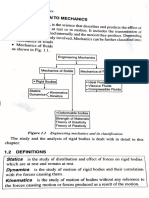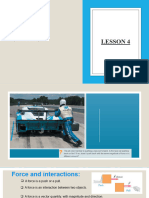Engineering Mechanics Notes
Uploaded by
Tekeshwar kumarEngineering Mechanics Notes
Uploaded by
Tekeshwar kumar+ @ cosl947? TPy=0 R=5Ry = 150 +225.01 maghs.s0 Paantnaisereo RoBi «150 cas" + 25.01 costo 1ST Q=22501N . 10-2021 P Base (Ast, Profs), GEC. Iglu, Basar (C.6.)494001, “ perpendicular distance of he penne ce of the point ean the Product ofthe Moment of the line of at magnitude of F about point 1 is given by, ofaatonafitefoce ne seme Similarly, Micka M,= ~* 5 fasca a= Fay ce M=Fa Q What will be the unit of Moment? ent = Force x Perpendicular distance ea > The point abc i ; out which the perpendicular dis moment is considered "poh de fon on as Joon Monet Seah moment eo centre lies on the line of action of the force, then moment arm is zero, $0 ss-192m1 rome 0 ETE wun eC upp, ban YO! « St iv ncn ws Brine of nanan > The algebraic sum of moments of SYETE of coplanar forces about a moment cere js equal to Teer ent of thei resultant about the se moment centre. ‘Moment of resultant about © Rad = Roc= R. 02 cos8 = 02. Reosd= 08 Ry jy, moment of force Fy about © F,dy= Fyob= Fr 02 c0s0= 08 Fiat 200. Fy) Similarly, moment of force F, about ° Fydp2 08 Fag) Now, (2)43) Fy dy Fad 08 Fiat 0% Fa Fd) + Fad 08 Fie Fad) Fd +Fid,= 00 Re Fydy + Fd Rd (I) soa se Pte. 0B ae Bate 6 49001 negative sign. velockwise moment taki jgn and anticlockwis > Clockwise moment taking positive § Force F is making CCW rotation about point B, cy aa Force F is making CW rotation about point A, M,=+Fd F, = oat « a Beare (A Pte, GEC nap, Dana (C)494001 NUMERICALS BASED ON MOMENT a a SSS SE RSET | Q.12) Find out th i about point A, B, Cand D. . jut the moment about point an sen 15kN Soln. M,=-84 + 10,344) —15.(143+4) A 7 a . M,=~82 KN.m Similarly, at cx M, =~54+ 10.3 - 15.(1+3) eo — 4m 3m Tm M,=~50kN.m Mc =~ 5.(443) + 8.3 15.1 Mc=~26KN.m Mp =~ 5.(443+1) + 8,(341)- 10.1 18 kN esto Bure (Att Profs), GEC. pau, Bar (C.G)-494001, o B= 21) +3, My=24 un, WA) 5 Mc= 5Q)+ 341 +44 Me= 18am “3.4 Mom ws 050). 20) +1, Mp= “ia (2) + 1,42)— My=~26 40 (2) ~3, 1020) s pnb 38)~240)s 1.0) +4) (3) ) Q)-3,1) (1) -3.3) eine (Ast. Pte, CC, Bae (6.45401 = CLASSIFICATION OF 1.21: PARALLEL FORCES INA PLANE > System of forces whose lines of action are parallel to each other PARALLEL FORCES PARALLEL FORCES f Like Parallel Forces R F; os.toaa Forces are in same direction (LS Unlike Parallel Forces Forces are in opposite direction Ry Equal unlike ‘Unequal unlike Parallel Forces Parallel Forces R=F Daj (Ast. Pfes), GEC. apnp, Bana (C6)}44001 RR Rh mek, s couple. eppost parle forces are OW” & 7 eanotterenedy #02 Es a sepacd bY eden ttt the body Sey COUPES” OTE a > co cer eming coe at > The sum ofthe fo effect ofthe couple is 2210. we Moment ofthe forces constituting a couple about Ps : (end ofthe arm coset eM tR ; ple about pont Cy amoment. rns that the translatory F, Moment ofthe forces constituting a (Girthe arn) Mc=Faa+Ra2= Ra Moment of the forces constituting « couple about point D, (Outside the arm) My=Rad, =F(,-4)= Fd oe i. Pt ORE 040 1.22: COUPLE. NOTE: 1. The algebraic sum of the forces forming a couple is zero. ER=F-F=0 2. The algebraic sum of the moments, of the moment centre chosen. M=Rd 3. Toadd two couples take the algebraic sum of their moments, 4. The couple is rotated through any angle. independent of the position of the two forces forming a coupl s.toana1 : PDs (Aa Prof, GEC gdp, Bases (.0.}494001 1.23: RESOLUTIO. IN OF A FORCE INTO A FOR CE & A COUPLE Of, 8 ro JO bgp, Bac 40" esioam je At Pre NUMERICALS rm of forces actig on beam a8 SROW in figure. {Q.13) Determine the resultant of the syst 20% 30KN 20KN 4 B Soln: Let resultant Risacting at® distance of ¥ from Fy = 0 (No Horizontal force) end A op -20-30-202-70 iN ‘Apply Varignon theorem about point A so, Resultant pxe Fd * Fed * Feds 0.x = 2041 5) + 30.3) +2046) oN ETT ERT OFF GRD oe : Cae Oe se = 249770 = 3.43 m (From end A) ajo pe 8 mpi Bae COM sion aris subject |e 10 A i i eae reduce this system (© (a) singe forse GAsingl forcemoment 6% MA ( Asingl force-moment 75 at. soins BF 0 (No Horizontal free) et resultant Rs #6008 at a distance of x from 0, Re ne seen 10-25-08 ‘apply Varignon theore” about point A $0, Resultant (GET GRF en = Frid Fats ods "GET ER > ore Gh ' oe on (ort GR 60.x= 60.(40)- 10,(70) + 25.1120) i c= 4790/60 = 7833 €™ = 0.783 m (From end A) soa jes note GBC a Bae COT % NUMERICALS (a) Asingle force 1s] oy oN [25N R=60N |__tsren_] al on [0m Poem" * 3 B b) Asingle foree-moment system at A R=60N o73m__| Reon s B B R=60N —— B h M = 60x0.783= 46.98 Nm stom aj (At, Profene), EC nghpr, Baar (€.0) 9400 % a — Os17m A a : Ser 7 ‘P.Basjare (Asst, Professor), G.E.C.Jngdalpar, Bastar (C.G)}-494001 nm 4.24: SUPPORT, SUPPORT REACTION & TYPES OF SUPPORT ‘SUPPORT: It is a structure or an object, which restricts the free motion of another body. SUPPORT REACTION: Reactions are self adjusting frees developed by other bodies which are in contact with the body under consideration. port al R | support Reaction No Motion of the reaction is normal to the NOTE: Ifthe surface of contact is smooth (Le. ficionless), then die surface of contact. And its direction is always towards the body. es192m arr (At. Prin), Cp Bu (C0)-49401 RT... ES OF SUPPO! 124: SUPPORT, SUPPORT REACTION & Ty? TYPES OF SUPPORT: There are 4 types of SUPPOTS. at the point of contact tothe 1. Frictioaless‘Simple Support: Reaction acts normal 477 R| sets the movement of the object normal 10 i restricts the i ‘Aand B. 2) RateerKaile edge Supper: Role ee eR aus normal tthe surface atthe pint of contact. the suri "So reactions normal w w | w | Le ok | A : - ¢ S A a A | 7 - sea 1 tae at Pst OE pip, bn (©6 4801 ” 2) Hinge/Pin Support: Hinge or pin restricts the motion in both horizontal and vertical direction. So horizontal 4 well as vertical reactions are applied. w w w Brea G Ray Rey Mae's rns SeeberE sco A ft eam AB is embeded fed in the concrete restricts the mation er Re ge Ain he oizontal and the vertical drctons. I also rests lke anne of about ‘eavaal and vertical rection t pint Aare accompanied by aeacson coogi t,o Cea bom he point A. So w w P Ber (Aut Prien GEC Jagr, Bomar (CG. js es EM\=0 ad Ry ax 0 A 1000 * (1+ 0.25)—Ryy* (1) =0 rr0 Ruy = 1250 Pat ine R, an. (0) ee Ray 1280 = 1000 say + Rgy 1000 a(t) Ray = 250N esos 1 een At Pn ti ate CON z NUMERICALS BASED ON TYPES OF SUPPORT Q:6) A force of support a c Solution: FBD Cis atthe centre ofthe beam AB, So AC=BC M50 000 sis? zene 5000 sin30® x (AC)~ Ray (AB)=0 Rx $000cos300- 0 Ryy* AC) = 2500» (AC) 8 Rc = 4330.13 Rey = 1290 Ry a oe Put ineqa. (1) | = gy 1250 = 2500 me Rat Ray ~5000 sin30°=0 nae Rwy Ry*Ray =2500 0) esioamat Bara (Ast Prfhene), GC.aplr,Basr (COHN +5000 sin30* ‘Net resuttant reaction at A i8 Bx R, Ry = VR + Rav? = aaa Ta + A250 ea Ra Ry = 4506.94N 000 sin30" Direction, Rag - 433013 eo8 tno = RE" saad Ryy= 1250 Ry = 4506.94N 0=73.90° ye (At Pt, GEC. aghr, Baie C0401 NUMERICALS BASED ON TYPES OF SUPPORT 1Q17) Acorner plate ABC is hinged toa xed support at Aand ress ona roller at C, Ia force of W = 1000 N is acting sishown in figure, Find the reactions at the supports. rh} toon Rx . Solution: FED tn =M,=0 Net resultant reaction at Ais Ry x 1000 « (30) Rex (40)=0 RyRy 0 tl Bata “0g = T80N 2, = (Ra Ra? eee Putin eqn. (1) R= a lined soe 4 = $750) + L000)? Se ral a R, = 1250N Ry = 750N 1030 Dasa (At Profit, GEC. apap, Baar (C.0)404001 NUMERIC, ‘ALS BASED ON Typrs OF suprort 416) Determine ‘Nand located ns given figure ‘Meet at Aand located ag qg ‘ ‘P= S000N pete p Satin: FD Rw Rwy SE ema Tro Iso Rysc- $000 cos30°= 9 5000 sind? x (AC 500090" = sin30° x (AC) Ry (AB)= 0 Rox = 4330.13 yy (ZAC) = 2500» (AC) i 5 Ryy = 1250 Reg cee cao f Rey*ReyS000sina0¢=o ‘Rr 1250"2500 Ry Ray RiytRey 2500 gy Ta" SON " ‘P.Banjre (Ast. Professe), G.E.C. Jia, Basar (C.G)494008 ss NUMERICALS BASED ON GENERAL CASES OF FORCES IN A PLANE {Q.17) Determine the magoitude of the pull exerted on the nall Af horizontal force of 200 Nis Srplled to handle of a nail puller as shown in figure. Determine the magnitude oF te pull served on the nail A if horizontal force of 200 N is applied of a nail puller as shown in igure. Solution: FBD EM, =0 200 x (24) + R,c0s20° x (3)= 0 Ry = - 1702.68N stoamt Pore (Ast Profs). GEC. nda as (C. 404001
You might also like
- Engineering-Mechanics-I Mod I and Mod IINo ratings yetEngineering-Mechanics-I Mod I and Mod II47 pages
- 1st_SEM_GP1_Dynamics_Forces_and_Newtons_Law_of_Motion-1No ratings yet1st_SEM_GP1_Dynamics_Forces_and_Newtons_Law_of_Motion-141 pages
- SM-1-UNIT-1 (1) INTRODUCTION-Laws of Forces (Structrual Mechanics)No ratings yetSM-1-UNIT-1 (1) INTRODUCTION-Laws of Forces (Structrual Mechanics)42 pages
- Program of "Physics": Lecturer: Dr. DO Xuan Hoi Room A1. 503 E-MailNo ratings yetProgram of "Physics": Lecturer: Dr. DO Xuan Hoi Room A1. 503 E-Mail53 pages
- To Elements of Mechanical Engineering: Nalinikanta Panda, Asst. Prof., Mechanical DeptNo ratings yetTo Elements of Mechanical Engineering: Nalinikanta Panda, Asst. Prof., Mechanical Dept70 pages
- Physics 1 - LESSON 4 (Mid - Fall 24-25)No ratings yetPhysics 1 - LESSON 4 (Mid - Fall 24-25)15 pages
- PHYS-20034-IM-Physics-for-Engineers (1)No ratings yetPHYS-20034-IM-Physics-for-Engineers (1)171 pages
- Draft Copy: Getting The Most From This BookNo ratings yetDraft Copy: Getting The Most From This Book104 pages
- Lecture03 - Chapter4 - Newton's Laws of MotionNo ratings yetLecture03 - Chapter4 - Newton's Laws of Motion29 pages
- Fundamental of Mechanics 2nd Year 1st SemesterNo ratings yetFundamental of Mechanics 2nd Year 1st Semester429 pages
- Engineering Mechanics by Dhiman and KulshereshthaNo ratings yetEngineering Mechanics by Dhiman and Kulshereshtha23 pages
- 14+Important+Coding+Rules+to+Learn+from+Great+DevelopersNo ratings yet14+Important+Coding+Rules+to+Learn+from+Great+Developers7 pages
- 1st_SEM_GP1_Dynamics_Forces_and_Newtons_Law_of_Motion-11st_SEM_GP1_Dynamics_Forces_and_Newtons_Law_of_Motion-1
- SM-1-UNIT-1 (1) INTRODUCTION-Laws of Forces (Structrual Mechanics)SM-1-UNIT-1 (1) INTRODUCTION-Laws of Forces (Structrual Mechanics)
- Program of "Physics": Lecturer: Dr. DO Xuan Hoi Room A1. 503 E-MailProgram of "Physics": Lecturer: Dr. DO Xuan Hoi Room A1. 503 E-Mail
- To Elements of Mechanical Engineering: Nalinikanta Panda, Asst. Prof., Mechanical DeptTo Elements of Mechanical Engineering: Nalinikanta Panda, Asst. Prof., Mechanical Dept
- 14+Important+Coding+Rules+to+Learn+from+Great+Developers14+Important+Coding+Rules+to+Learn+from+Great+Developers

































































